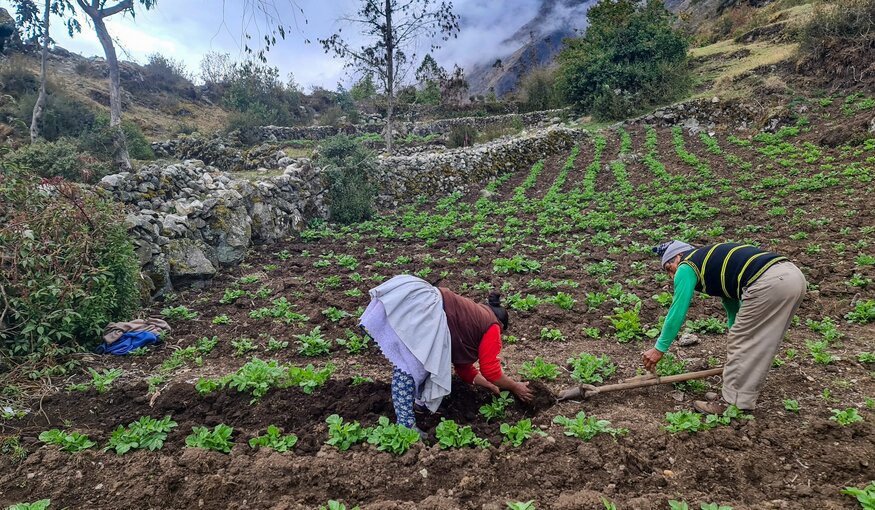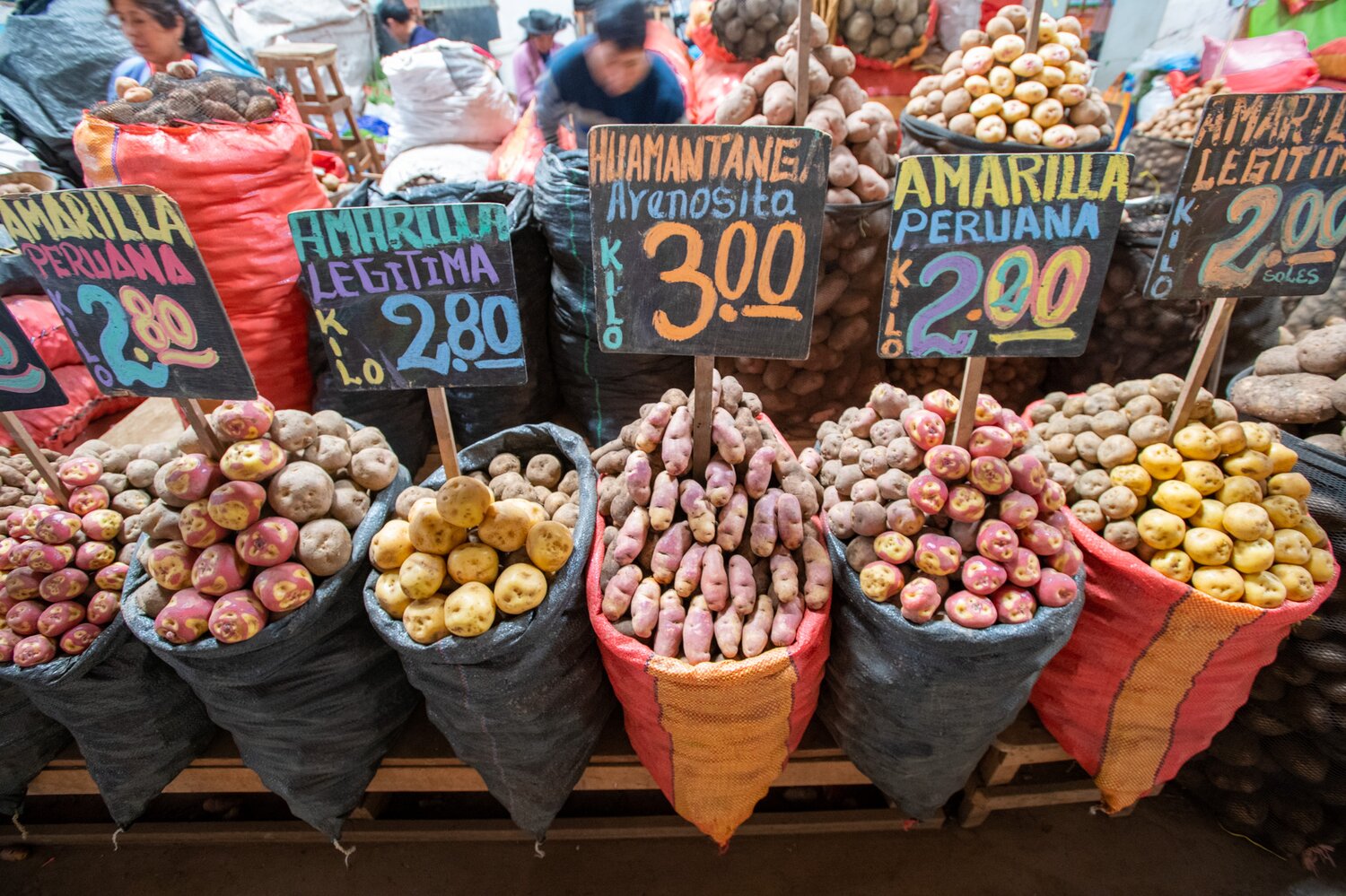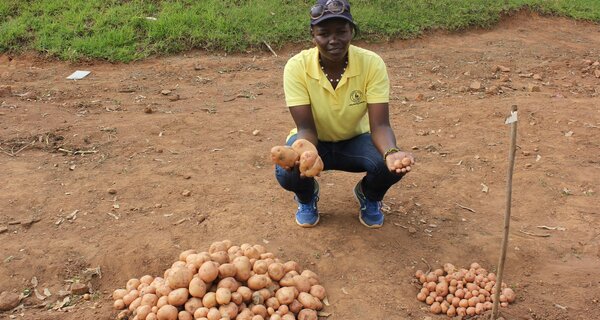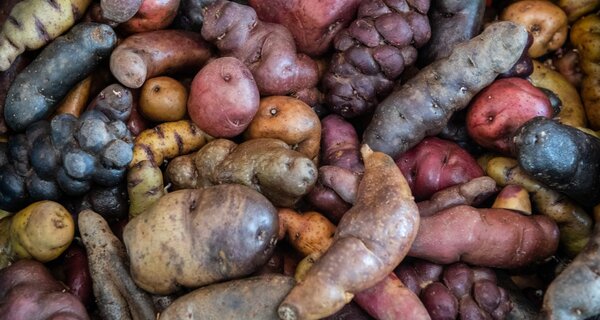Global Guardians of Potato Diversity

Field work of Aguapan farmers in the Andean highlands at 3,500 meters. Photo: Manuela Nagel/IPK
9 August 2023
In the highlands of Peru, a group of farmers safeguard their livelihoods and those of future generations. They are conserving the diversity of their staple food: the potato.
Some members of AGUAPAN (Association of Guardians of the Native Potato of Central Peru) cultivate hundreds of potato landraces – traditional local varieties. As well as conserving diversity, they are also nurturing traditional knowledge.
But these guardians of potato diversity can’t do it alone. Cultivated potato is the third most consumed crop globally and important not only for food, but also for the animal feed, pharmaceutical, textile and paper industries. To ensure that potato diversity is conserved forever, a global effort is required. And that’s why the Crop Trust supported a project to update a global crop conservation strategy for the crop.
“There are thousands of landraces of potatoes,” said Manuela Nagel, a plant genetic resources specialist at the Leibniz Institute of Plant Genetics and Crop Plant Research (IPK) and lead author of the strategy. “The Indigenous farmers of the Andes alone grow more than 3,000 types. It’s only fair to ask: should we be concerned about conserving all this diversity?”
All of these landraces have, over time, developed mechanisms to cope with all sorts of challenges, including pests and diseases, drought, and high temperatures.
Plant breeders can harness the diversity of landraces by using a range of techniques to select from a whole ‘menu’ of traits, which they can then use to breed improved potato varieties that are more resilient to the challenges of today and the unknown challenges of the future.
Vanishing Potatoes
But that diversity is also eroding away. “For example, in Chile, Indigenous and peasant communities once grew between 800 to 1,000 native potato varieties,” said Manuela. “Nowadays, they only grow about 270.”
The reasons for this decline can be complex.
Many farmers are migrating, and others are replacing their traditional potatoes with improved varieties or other crops. Markets often dictate what farmers grow: for example, in order to fry up perfect golden fries for hungry customers across the globe, McDonald’s prefers large, long and blemish-free potatoes. Many varieties are just the wrong shape, though they may be great in other ways.
The changing temperature and rain patterns in some areas are resulting in more pests, diseases and other stresses, such as drought. In particular, pests and diseases can severely affect potatoes. The European and Mediterranean Plant Protection Organization has identified 19 quarantine pests, each of which can cause up the total loss of potato crops. After all, it only took one nasty disease to cause the Irish Potato Famine and starve 1 million people in the mid-1800s.
Beside traditional varieties, we’re also losing the wild relatives of potatoes. Among wild potatoes, 26 species are on the IUCN Red List of endangered species, threatened by habitat loss, fire and disturbance by humans and livestock.

Potato diversity in Huancayo central market. Photo: Michael Major for Crop Trust
Strategizing to Ensure Diversity
To get an overview of the current state of the conservation and use of potato genetic resources, the Crop Trust commissioned an update to a potato conservation strategy first developed in 2006. It’s one of 15 new or updated strategies that have been funded by the German Federal Ministry of Food and Agriculture (BMEL).
The updated potato strategy identified gaps in genebank collections and prioritized which should be filled in order to capture the full range of diversity and make it available to future generations.
The authors of the strategy also conducted a global inventory to determine how much potato diversity is in situ, or in farmers’ fields, and how much is ex situ, that is stored in genebanks.
“We documented in situ projects in Peru, Bolivia, Ecuador, Argentina, Chile and Brazil that have developed conservation sites and strategies to maintain potato genetic diversity and preserve the associated knowledge, culture and traditions,” said Manuela.
The authors also found that 89 national institutes and four international or regional centers located in 59 countries maintain collections of potato diversity.
Establishing Priorities
Based on the data acquired, the authors were able to identify a set of ten action points. “We conducted a comprehensive analysis of the data and listened to the major constraints and priorities that the stakeholders identified,” said Manuela. “Based on that we identified 10 action points as strategic priorities.”
One point addresses genotyping the varieties currently held in situ and ex situ. Genotyping is a way of describing the genetic composition of a particular potato plant. That makes it easier for breeders to select samples for their improvement programs, and genebanks to decide what to conserve.
Another action point calls for protecting the natural habitat of wild potato species and organizing collecting missions, so potatoes out in farmers’ fields and in nature can be found and conserved before they are lost.
Cultivated potatoes can’t be conserved as seeds like many other crops. But vegetative material of potatoes can be put into a deep freeze to conserve them. A very deep freeze. So the strategy calls for supporting the Global Plant Cryopreservation Initiative.
The AGUAPAN guardians can rest assured that they are not alone: there’s a plan for the potato diversity they are nurturing to be conserved, forever. But we cannot let them down. The plan must become a reality. And for that, money will be needed.
Download Global Strategy for the Conservation of Potato
Categories: Global Crop Conservation Strategies, Potato
About the Global Crop Conservation Strategy project
The development of this Global Crop Conservation Strategy was funded by the German Federal Ministry of Food and Agriculture (BMEL) as part of a three-year project led by the Crop Trust: “Breathing New Life into the Global Crop Conservation Strategies: Providing an Evidence Base for the Global System of Ex situ Conservation of Crop Diversity.”



